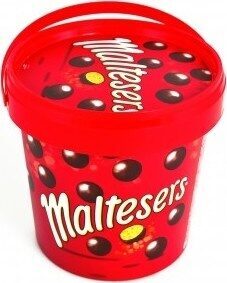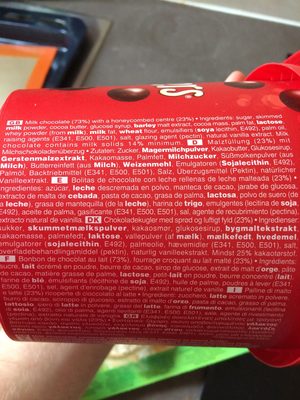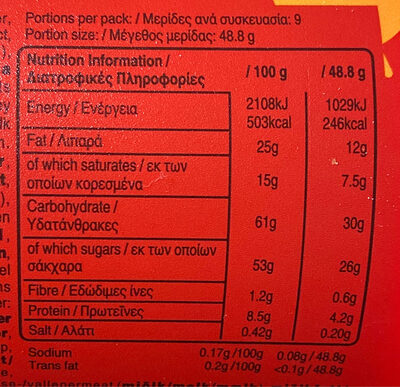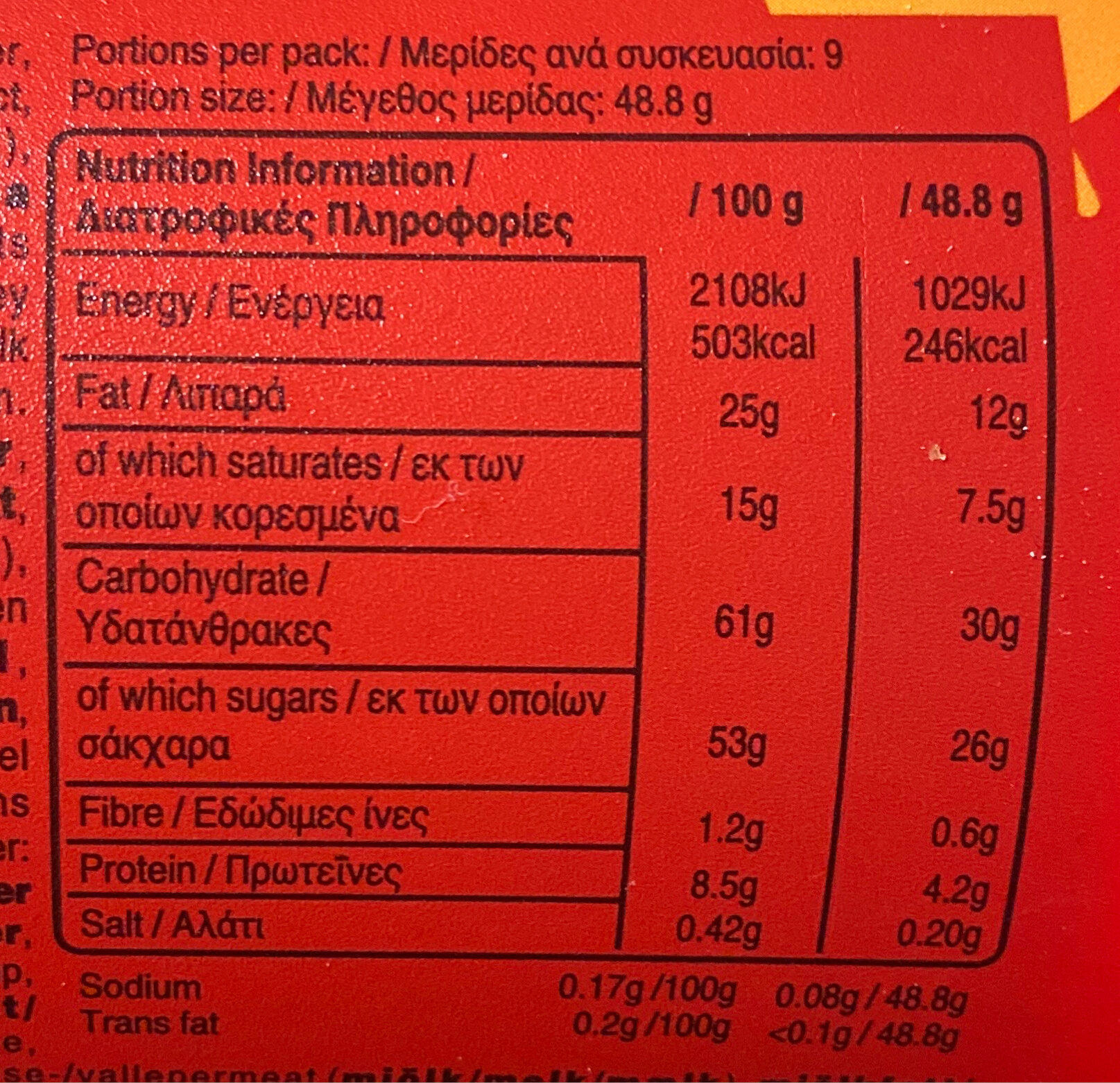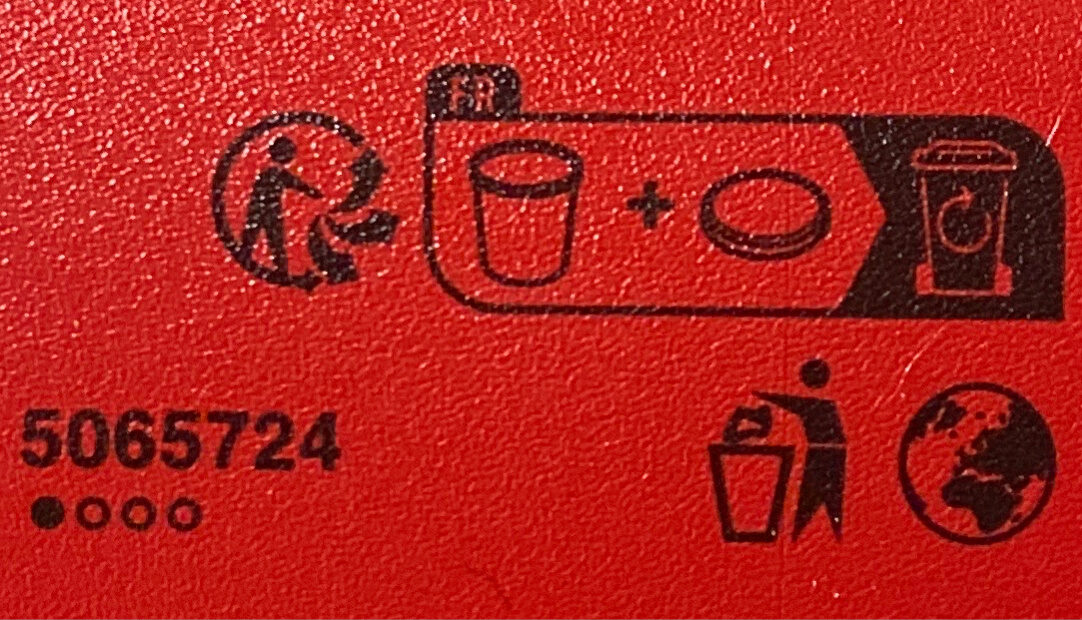Help us make food transparency the norm!
As a non-profit organization, we depend on your donations to continue informing consumers around the world about what they eat.
The food revolution starts with you!
Maltesers Chocolate Bucket - 440g
Maltesers Chocolate Bucket - 440g
This product page is not complete. You can help to complete it by editing it and adding more data from the photos we have, or by taking more photos using the app for Android or iPhone/iPad. Thank you!
×
Streckkod: 5000159335737 (EAN / EAN-13)
Kvantitet: 440g
Varumärken: Maltesers
Kategorier: Snacks, Söta snacks, en:Cocoa and its products, Konfekt, Chokladgodis
Etiketter, certifieringar, utmärkelser:
Tidy man, Triman
Ingredients ursprung: Storbritannien
Butiker: Stockomani
Länder där såld: Danmark, Frankrike, Tyskland, Grekland, Norge, Sverige, Storbritannien
Matching with your preferences
Hälsa
Ingredienser
-
54 ingredienser
Franska: sucre, lait écrémé en poudre, beurre de cacao, sirop de glucose, extrait de malt d'orge, pâte de cacao, matière grasse de palme, lactose, petit-lait en poudre, beurre concentré (lait), farine de blé, émulsifiants (lécithine de soja, E492), huile de palme, poudres à lever (E341, E500, E501), sel, agent d'enrobage (pectine), extrait naturel de vanille. Palline di malto e latte (23%) ricoperte di cioccolato al latte ? Ingredienti: zucchero, latte scremato in po/vere. burro di cacao, sciroppo di glucosio, estratto di malto d'orzo, pasta di cacao, grasso di palma, 'attosio, siero di latte in polvere. grassi del latte. farina di frumento, emu/sionanti (/ecitina scia, E492), olio di palma, agenti lievitanti (E341, E500, E501), sale, agente dl rivestimento (pectinaò, estratto naturale di vaniglia. EÀact»ptÉq 00KOÀatÉV(CÇ LITtaAir-oeq tpavav» Kcu (2.3%) ? C.cixaon. govnc.Allergener: Gluten, Mjölk, Soja
Food processing
-
Ultra processed foods
Elements that indicate the product is in the 4 - Ultra bearbetade livsmedel och drycker group:
- Tillsats: E322 - Lecitiner
- Tillsats: E440 - Pektiner
- Tillsats: E492 - Sorbitantristearat
- Ingrediens: Emulgeringsmedel
- Ingrediens: Ytbehandlingsmedel
- Ingrediens: Glukos
- Ingrediens: Glukossirap
- Ingrediens: Laktos
- Ingrediens: Vassle
Food products are classified into 4 groups according to their degree of processing:
- Obearbetade eller minimalt bearbetade livsmedel
- Bearbetade kulinariska ingredienser
- Halvfabrikat
- Ultra processed foods
The determination of the group is based on the category of the product and on the ingredients it contains.
Tillsatser
-
E322 - Lecitiner
Lecithin: Lecithin -UK: , US: , from the Greek lekithos, "egg yolk"- is a generic term to designate any group of yellow-brownish fatty substances occurring in animal and plant tissues, which are amphiphilic – they attract both water and fatty substances -and so are both hydrophilic and lipophilic-, and are used for smoothing food textures, dissolving powders -emulsifying-, homogenizing liquid mixtures, and repelling sticking materials.Lecithins are mixtures of glycerophospholipids including phosphatidylcholine, phosphatidylethanolamine, phosphatidylinositol, phosphatidylserine, and phosphatidic acid.Lecithin was first isolated in 1845 by the French chemist and pharmacist Theodore Gobley. In 1850, he named the phosphatidylcholine lécithine. Gobley originally isolated lecithin from egg yolk—λέκιθος lekithos is "egg yolk" in Ancient Greek—and established the complete chemical formula of phosphatidylcholine in 1874; in between, he had demonstrated the presence of lecithin in a variety of biological matters, including venous blood, in human lungs, bile, human brain tissue, fish eggs, fish roe, and chicken and sheep brain. Lecithin can easily be extracted chemically using solvents such as hexane, ethanol, acetone, petroleum ether, benzene, etc., or extraction can be done mechanically. It is usually available from sources such as soybeans, eggs, milk, marine sources, rapeseed, cottonseed, and sunflower. It has low solubility in water, but is an excellent emulsifier. In aqueous solution, its phospholipids can form either liposomes, bilayer sheets, micelles, or lamellar structures, depending on hydration and temperature. This results in a type of surfactant that usually is classified as amphipathic. Lecithin is sold as a food additive and dietary supplement. In cooking, it is sometimes used as an emulsifier and to prevent sticking, for example in nonstick cooking spray.Källa: Wikipedia (Engelska)
-
E322i - Lecitin
Lecithin: Lecithin -UK: , US: , from the Greek lekithos, "egg yolk"- is a generic term to designate any group of yellow-brownish fatty substances occurring in animal and plant tissues, which are amphiphilic – they attract both water and fatty substances -and so are both hydrophilic and lipophilic-, and are used for smoothing food textures, dissolving powders -emulsifying-, homogenizing liquid mixtures, and repelling sticking materials.Lecithins are mixtures of glycerophospholipids including phosphatidylcholine, phosphatidylethanolamine, phosphatidylinositol, phosphatidylserine, and phosphatidic acid.Lecithin was first isolated in 1845 by the French chemist and pharmacist Theodore Gobley. In 1850, he named the phosphatidylcholine lécithine. Gobley originally isolated lecithin from egg yolk—λέκιθος lekithos is "egg yolk" in Ancient Greek—and established the complete chemical formula of phosphatidylcholine in 1874; in between, he had demonstrated the presence of lecithin in a variety of biological matters, including venous blood, in human lungs, bile, human brain tissue, fish eggs, fish roe, and chicken and sheep brain. Lecithin can easily be extracted chemically using solvents such as hexane, ethanol, acetone, petroleum ether, benzene, etc., or extraction can be done mechanically. It is usually available from sources such as soybeans, eggs, milk, marine sources, rapeseed, cottonseed, and sunflower. It has low solubility in water, but is an excellent emulsifier. In aqueous solution, its phospholipids can form either liposomes, bilayer sheets, micelles, or lamellar structures, depending on hydration and temperature. This results in a type of surfactant that usually is classified as amphipathic. Lecithin is sold as a food additive and dietary supplement. In cooking, it is sometimes used as an emulsifier and to prevent sticking, for example in nonstick cooking spray.Källa: Wikipedia (Engelska)
-
E341 - Kalciumfosfater
Calcium phosphate: Calcium phosphate is a family of materials and minerals containing calcium ions -Ca2+- together with inorganic phosphate anions. Some so-called calcium phosphates contain oxide and hydroxide as well. They are white solids of nutritious value.Källa: Wikipedia (Engelska)
-
E440 - Pektiner
Pectin: Pectin -from Ancient Greek: πηκτικός pēktikós, "congealed, curdled"- is a structural heteropolysaccharide contained in the primary cell walls of terrestrial plants. It was first isolated and described in 1825 by Henri Braconnot. It is produced commercially as a white to light brown powder, mainly extracted from citrus fruits, and is used in food as a gelling agent, particularly in jams and jellies. It is also used in dessert fillings, medicines, sweets, as a stabilizer in fruit juices and milk drinks, and as a source of dietary fiber.Källa: Wikipedia (Engelska)
-
E492 - Sorbitantristearat
Sorbitan tristearate: Sorbitan tristearate is a nonionic surfactant. It is variously used as a dispersing agent, emulsifier, and stabilizer, in food and in aerosol sprays. As a food additive, it has the E number E492. Brand names for polysorbates include Alkest, Canarcel, and Span. The consistency of sorbitan tristearate is waxy; its color is light cream to tan.Källa: Wikipedia (Engelska)
-
E500 - Natriumkarbonater
Sodium carbonate: Sodium carbonate, Na2CO3, -also known as washing soda, soda ash and soda crystals, and in the monohydrate form as crystal carbonate- is the water-soluble sodium salt of carbonic acid. It most commonly occurs as a crystalline decahydrate, which readily effloresces to form a white powder, the monohydrate. Pure sodium carbonate is a white, odorless powder that is hygroscopic -absorbs moisture from the air-. It has a strongly alkaline taste, and forms a moderately basic solution in water. Sodium carbonate is well known domestically for its everyday use as a water softener. Historically it was extracted from the ashes of plants growing in sodium-rich soils, such as vegetation from the Middle East, kelp from Scotland and seaweed from Spain. Because the ashes of these sodium-rich plants were noticeably different from ashes of timber -used to create potash-, they became known as "soda ash". It is synthetically produced in large quantities from salt -sodium chloride- and limestone by a method known as the Solvay process. The manufacture of glass is one of the most important uses of sodium carbonate. Sodium carbonate acts as a flux for silica, lowering the melting point of the mixture to something achievable without special materials. This "soda glass" is mildly water-soluble, so some calcium carbonate is added to the melt mixture to make the glass produced insoluble. This type of glass is known as soda lime glass: "soda" for the sodium carbonate and "lime" for the calcium carbonate. Soda lime glass has been the most common form of glass for centuries. Sodium carbonate is also used as a relatively strong base in various settings. For example, it is used as a pH regulator to maintain stable alkaline conditions necessary for the action of the majority of photographic film developing agents. It acts as an alkali because when dissolved in water, it dissociates into the weak acid: carbonic acid and the strong alkali: sodium hydroxide. This gives sodium carbonate in solution the ability to attack metals such as aluminium with the release of hydrogen gas.It is a common additive in swimming pools used to raise the pH which can be lowered by chlorine tablets and other additives which contain acids. In cooking, it is sometimes used in place of sodium hydroxide for lyeing, especially with German pretzels and lye rolls. These dishes are treated with a solution of an alkaline substance to change the pH of the surface of the food and improve browning. In taxidermy, sodium carbonate added to boiling water will remove flesh from the bones of animal carcasses for trophy mounting or educational display. In chemistry, it is often used as an electrolyte. Electrolytes are usually salt-based, and sodium carbonate acts as a very good conductor in the process of electrolysis. In addition, unlike chloride ions, which form chlorine gas, carbonate ions are not corrosive to the anodes. It is also used as a primary standard for acid-base titrations because it is solid and air-stable, making it easy to weigh accurately.Källa: Wikipedia (Engelska)
-
E501 - Kaliumkarbonater
Potassium carbonate: Potassium carbonate -K2CO3- is a white salt, which is soluble in water -insoluble in ethanol- and forms a strongly alkaline solution. It can be made as the product of potassium hydroxide's absorbent reaction with carbon dioxide. It is deliquescent, often appearing a damp or wet solid. Potassium carbonate is used in the production of soap and glass.Källa: Wikipedia (Engelska)
Ingrediensanalys
-
Palmolja
Ingredienser som innehåller palmolja: Palmfett, Palmolja
-
Icke-vegan
Non-vegan ingredients: Skummjölkspulver, Laktos, Vasslepulver, SmörfettVissa ingredienser kunde inte kännas igen.
Vi behöver din hjälp!
You can help us recognize more ingredients and better analyze the list of ingredients for this product and others:
- Edit this product page to correct spelling mistakes in the ingredients list, and/or to remove ingredients in other languages and sentences that are not related to the ingredients.
- Add new entries, synonyms or translations to our multilingual lists of ingredients, ingredient processing methods, and labels.
If you would like to help, join the #ingredients channel on our Slack discussion space and/or learn about ingredients analysis on our wiki. Thank you!
-
Vegetarisk status okänd
Okända ingredienser: fr:palline-di-malto-e-latte, fr:ricoperte-di-cioccolato-al-latte-ingredienti, fr:zucchero, fr:latte-scremato-in-po, fr:vere, fr:burro-di-cacao, fr:sciroppo-di-glucosio, fr:estratto-di-malto-d-orzo, fr:pasta-di-cacao, fr:grasso-di-palma, fr:attosio, fr:siero-di-latte-in-polvere, fr:grassi-del-latte, fr:farina-di-frumento, fr:emu, fr:sionanti, fr:ecitina-scia, fr:olio-di-palma, fr:agenti-lievitanti, fr:sale, fr:agente-dl-rivestimento, fr:pectinao, fr:estratto-naturale-di-vaniglia, fr:eaact-pteq-00koaatev, fr:cc-littaair-oeq-tpavav-kcu, fr:c-cixaon, fr:govncVissa ingredienser kunde inte kännas igen.
Vi behöver din hjälp!
You can help us recognize more ingredients and better analyze the list of ingredients for this product and others:
- Edit this product page to correct spelling mistakes in the ingredients list, and/or to remove ingredients in other languages and sentences that are not related to the ingredients.
- Add new entries, synonyms or translations to our multilingual lists of ingredients, ingredient processing methods, and labels.
If you would like to help, join the #ingredients channel on our Slack discussion space and/or learn about ingredients analysis on our wiki. Thank you!
-
Details of the analysis of the ingredients
Vi behöver din hjälp!
Vissa ingredienser kunde inte kännas igen.
Vi behöver din hjälp!
You can help us recognize more ingredients and better analyze the list of ingredients for this product and others:
- Edit this product page to correct spelling mistakes in the ingredients list, and/or to remove ingredients in other languages and sentences that are not related to the ingredients.
- Add new entries, synonyms or translations to our multilingual lists of ingredients, ingredient processing methods, and labels.
If you would like to help, join the #ingredients channel on our Slack discussion space and/or learn about ingredients analysis on our wiki. Thank you!
fr: sucre, lait écrémé en poudre, beurre de cacao, sirop de glucose, extrait de malt d'orge, pâte de cacao, matière grasse de palme, lactose, petit-lait en poudre, beurre concentré, farine de blé, émulsifiants (lécithine de soja, e492), huile de palme, poudres à lever (e341, e500, e501), sel, agent d'enrobage (pectine), extrait naturel de vanille, Palline di malto e latte 23%, ricoperte di cioccolato al latte ? Ingredienti (zucchero), latte scremato in po, vere, burro di cacao, sciroppo di glucosio, estratto di malto d'orzo, pasta di cacao, grasso di palma, attosio, siero di latte in polvere, grassi del latte, farina di frumento, emu, sionanti (ecitina scia, e492), olio di palma, agenti lievitanti (e341, e500, e501), sale, agente dl rivestimento, pectinaò, estratto naturale di vaniglia, EÀact»ptÉq 00KOÀatÉV, CÇ LITtaAir-oeq tpavav» Kcu 2.3%, ? C.cixaon, govnc- sucre -> en:sugar - vegan: yes - vegetarian: yes - ciqual_proxy_food_code: 31016
- lait écrémé en poudre -> en:skimmed-milk-powder - vegan: no - vegetarian: yes - ciqual_food_code: 19054
- beurre de cacao -> en:cocoa-butter - vegan: yes - vegetarian: yes - ciqual_food_code: 16030
- sirop de glucose -> en:glucose-syrup - vegan: yes - vegetarian: yes - ciqual_proxy_food_code: 31016
- extrait de malt d'orge -> en:barley-malt-extract - vegan: yes - vegetarian: yes
- pâte de cacao -> en:cocoa-paste - vegan: yes - vegetarian: yes - ciqual_proxy_food_code: 16030
- matière grasse de palme -> en:palm-fat - vegan: yes - vegetarian: yes - from_palm_oil: yes - ciqual_proxy_food_code: 16129
- lactose -> en:lactose - vegan: no - vegetarian: yes
- petit-lait en poudre -> en:whey-powder - vegan: no - vegetarian: maybe
- beurre concentré -> en:butterfat - vegan: no - vegetarian: yes - from_palm_oil: maybe - ciqual_food_code: 16401
- farine de blé -> en:wheat-flour - vegan: yes - vegetarian: yes - ciqual_proxy_food_code: 9410
- émulsifiants -> en:emulsifier
- lécithine de soja -> en:soya-lecithin - vegan: yes - vegetarian: yes - ciqual_food_code: 42200
- e492 -> en:e492 - vegan: maybe - vegetarian: maybe
- huile de palme -> en:palm-oil - vegan: yes - vegetarian: yes - from_palm_oil: yes - ciqual_food_code: 16129
- poudres à lever -> en:raising-agent
- e341 -> en:e341 - vegan: yes - vegetarian: yes
- e500 -> en:e500 - vegan: yes - vegetarian: yes
- e501 -> en:e501 - vegan: yes - vegetarian: yes
- sel -> en:salt - vegan: yes - vegetarian: yes - ciqual_food_code: 11058
- agent d'enrobage -> en:glazing-agent
- pectine -> en:e440a - vegan: yes - vegetarian: yes
- extrait naturel de vanille -> en:natural-vanilla-extract - vegan: yes - vegetarian: yes - ciqual_food_code: 11065
- Palline di malto e latte -> fr:palline-di-malto-e-latte - percent: 23
- ricoperte di cioccolato al latte ? Ingredienti -> fr:ricoperte-di-cioccolato-al-latte-ingredienti
- zucchero -> fr:zucchero
- latte scremato in po -> fr:latte-scremato-in-po
- vere -> fr:vere
- burro di cacao -> fr:burro-di-cacao
- sciroppo di glucosio -> fr:sciroppo-di-glucosio
- estratto di malto d'orzo -> fr:estratto-di-malto-d-orzo
- pasta di cacao -> fr:pasta-di-cacao
- grasso di palma -> fr:grasso-di-palma
- attosio -> fr:attosio
- siero di latte in polvere -> fr:siero-di-latte-in-polvere
- grassi del latte -> fr:grassi-del-latte
- farina di frumento -> fr:farina-di-frumento
- emu -> fr:emu
- sionanti -> fr:sionanti
- ecitina scia -> fr:ecitina-scia
- e492 -> en:e492 - vegan: maybe - vegetarian: maybe
- olio di palma -> fr:olio-di-palma
- agenti lievitanti -> fr:agenti-lievitanti
- e341 -> en:e341 - vegan: yes - vegetarian: yes
- e500 -> en:e500 - vegan: yes - vegetarian: yes
- e501 -> en:e501 - vegan: yes - vegetarian: yes
- sale -> fr:sale
- agente dl rivestimento -> fr:agente-dl-rivestimento
- pectinaò -> fr:pectinao
- estratto naturale di vaniglia -> fr:estratto-naturale-di-vaniglia
- EÀact»ptÉq 00KOÀatÉV -> fr:eaact-pteq-00koaatev
- CÇ LITtaAir-oeq tpavav» Kcu -> fr:cc-littaair-oeq-tpavav-kcu - percent: 2.3
- ? C.cixaon -> fr:c-cixaon
- govnc -> fr:govnc
Näring
-
Bad nutritional quality
⚠ ️Warning: the amount of fruits, vegetables and nuts is not specified on the label, it was estimated from the list of ingredients: 0This product is not considered a beverage for the calculation of the Nutri-Score.
Positiva poäng: 1
- Proteiner: 5 / 5 (värde: 8.5, avrundat värde: 8.5)
- Fiber: 1 / 5 (värde: 1.2, avrundat värde: 1.2)
- Frukt, grönsaker, nötter och raps- / valnöt- / olivoljor: 0 / 5 (värde: 0, avrundat värde: 0)
Negativa poäng: 27
- Energi: 6 / 10 (värde: 2108, avrundat värde: 2108)
- Socker: 10 / 10 (värde: 53, avrundat värde: 53)
- Mättat fett: 10 / 10 (värde: 15, avrundat värde: 15)
- Natrium: 1 / 10 (värde: 168, avrundat värde: 168)
The points for proteins are not counted because the negative points are greater or equal to 11.
Näringsvärde: (27 - 1)
Nutri-Score:
-
Näringsvärden
-
Fett i hög kvantitet (25%)
What you need to know- A high consumption of fat, especially saturated fats, can raise cholesterol, which increases the risk of heart diseases.
Recommendation: Limit the consumption of fat and saturated fat- Choose products with lower fat and saturated fat content.
-
Mättat fett i hög kvantitet (15%)
What you need to know- A high consumption of fat, especially saturated fats, can raise cholesterol, which increases the risk of heart diseases.
Recommendation: Limit the consumption of fat and saturated fat- Choose products with lower fat and saturated fat content.
-
Sockerarter i hög kvantitet (53%)
What you need to know- A high consumption of sugar can cause weight gain and tooth decay. It also augments the risk of type 2 diabetes and cardio-vascular diseases.
Recommendation: Limit the consumption of sugar and sugary drinks- Sugary drinks (such as sodas, fruit beverages, and fruit juices and nectars) should be limited as much as possible (no more than 1 glass a day).
- Choose products with lower sugar content and reduce the consumption of products with added sugars.
-
Salt i måttlig kvantitet (0.42%)
What you need to know- A high consumption of salt (or sodium) can cause raised blood pressure, which can increase the risk of heart disease and stroke.
- Many people who have high blood pressure do not know it, as there are often no symptoms.
- Most people consume too much salt (on average 9 to 12 grams per day), around twice the recommended maximum level of intake.
Recommendation: Limit the consumption of salt and salted food- Reduce the quantity of salt used when cooking, and don't salt again at the table.
- Limit the consumption of salty snacks and choose products with lower salt content.
-
-
Näringsfakta
Näringsfakta Som såld
för 100 g / 100 mlCompared to: Chokladgodis Energi 2 108 kj
(503 kcal)+2 % Fett 25 g +1 % Mättat fett 15 g +15 % Kolhydrat 61 g +3 % Sockerarter 53 g +9 % Fiber 1,2 g −72 % Protein 8,5 g +46 % Salt 0,42 g +27 % Fruits‚ vegetables‚ nuts and rapeseed‚ walnut and olive oils (estimate from ingredients list analysis) 0 %
Miljö
-
Eco-score ej beräknad - Okänd miljöpåverkan
Vi kunde inte beräkna Eco-Score av denna produkt eftersom det saknas vissa data, kan du hjälpa till att slutföra det?Could you add a precise product category so that we can compute the Eco-Score? Lägg till en kategori
Förpackning
-
Packaging with a medium impact
-
Packaging parts
1 x Hink (PP 5 - polypropen)
1 x Lid (PP 5 - polypropen)
-
Packaging materials
Material % Packaging weight Packaging weight per 100 g of product Plast
-
Transportation
-
Origins of ingredients
Origins of ingredients with a medium impact
Origin of the product and/or its ingredients % of ingredients Impact Storbritannien 100 %Medium
Hotade arter
-
Contains palm oil
Drives deforestation and threatens species such as the orangutan
Tropical forests in Asia, Africa and Latin America are destroyed to create and expand oil palm tree plantations. The deforestation contributes to climate change, and it endangers species such as the orangutan, the pigmy elephant and the Sumatran rhino.
Report a problem
-
Incomplete or incorrect information?
Category, labels, ingredients, allergens, nutritional information, photos etc.
If the information does not match the information on the packaging, please complete or correct it. Open Food Facts is a collaborative database, and every contribution is useful for all.
Datakällor
Produkt tillagd den av kiliweb
Senast ändrad produktsida på av october-food-facts.
Produktsida också redigerad av epfoodeye, hamzehshawqi, openfoodfacts-contributors, yuka.SHFVeFBZNHFoYWd2cHNFVndnaUkwTkpLMmFPN2VqMmRHZU05SUE9PQ, yuka.sY2b0xO6T85zoF3NwEKvlk9MdOb1hh-VByzViF3U6NqfMszKW41T46rXYqs, yuka.sY2b0xO6T85zoF3NwEKvlmpXfcfAiTnDCSbToxKp4suCNZfPf_xJv6LXDKs.
